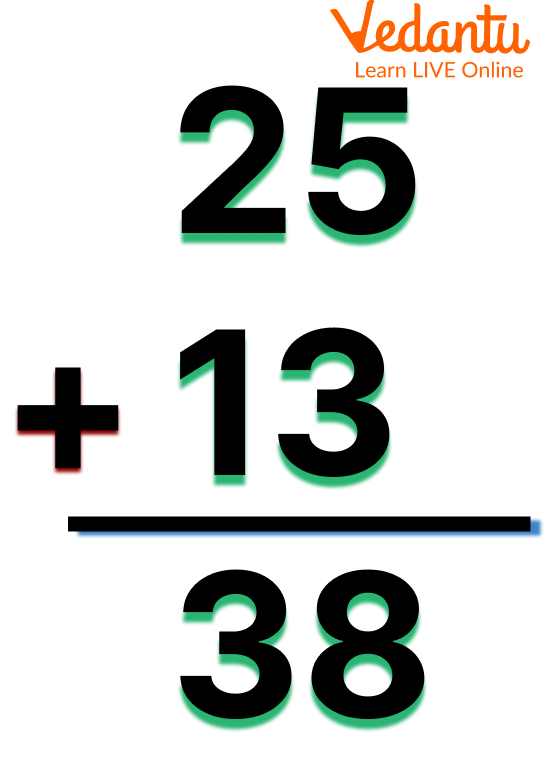




What Is Addition? Definition, Simple Tricks & Everyday Examples
Addition happens when you put two or more numbers together to find the total amount. The result of adding two or more numbers is called the sum. So, you would add your 4 cookies and your friend's 4 cookies to find that the sum is 8 cookies.
Addition is a mathematical operation that is used to add numbers. The sum of the provided numbers is the outcome of adding the given numbers. For instance, if we add 2 and 3, (2 + 3), the result is 5. We used the addition function on two numbers, 2 and 3, to get the sum, 5. In this article, we are going to see problems based on addition like the word problem of addition for class 1.
Addition Symbol
Different symbols are used in Mathematics. One of the most used arithmetic symbols is the addition symbol. We read about adding two integers, 2 and 3, in the definition of addition above. If we look at the addition pattern (2 + 3 = 5), we can see that the symbol (+) joins the two numbers and completes the supplied phrase. The addition symbol is made up of one horizontal and one vertical line. It is also known as the plus symbol (+) or the addition sign (+).
Simple Addition for Class 1
The basic formula of easy addition for Class 1 or the mathematical equation of addition can be explained as follows. Here, 2 and 5 are the addends and 7 is the sum.

Simple Addition
2 Digit Addition for Class 1
2-digit addition for Class 1 is a simple form of addiction in which numbers are placed according to their place value of ones and tens and then added. Once both columns are added, we obtain the final sum. For finding a total of two single-digit numbers, just count the first number on your fingers and then count the second number on your finger, and the sum of the total fingers is the result.

2-Digit Addition for Class 1
Carryover Addition for Class 1
When adding numbers, if the sum of the addends in any of the columns is more than 9, we regroup this amount into tens and ones. The tens digit of the sum is then carried over to the preceding column, and the one's digit of the sum is written in that column. In other words, we just write the number in the 'ones place digit' in that column, while moving the number in the 'tens place digit' to the column to the immediate left. With the help of an example, let us learn how to add two or more numbers in carrying over addition for Class 1.
Example: Add 3475 and 2865.
Solution: Let us follow the given steps:
Step 1: Start with the digits in one place. (5 + 5 = 10). Here the sum is 10. The tens digit of the sum, that is, 1, will be carried to the preceding column.
Step 2: Add the digits in the tens column along with the carryover 1. This means, 1 (carry-over) + 7 + 6 = 14. Here the sum is 14. The tens digit of the sum, that is, 1, will be carried to the hundreds place.
Step 3: Now, add the digits in the hundreds place along with the carryover digit 1. This means, 1 (carry-over) + 4 + 8 = 13. Here the sum is 13. The tens digit of the sum, that is, 1, will be carried to the thousands place.
Step 4: Now, add the digits in the thousands place along with the carryover digit 1, that is, 1 (carry-over) + 3 + 2 = 6
Step 5: Therefore, the sum of 3475 + 2865 = 6340
Addition Story Sums for Class 1
One morning, your mother called you and gave you 4 chocolates. After that, your father called you and gave you 5 chocolates. Amazing isn’t it? Now you have so many chocolates. Can you tell me how many chocolates you have? If you have to answer this question then you need to use addition.
Addition is basically counting the total number of objects you have. While adding two numbers, count forward the numbers equal to the second number after the first number. Addition will be easy if we take the bigger number and then count forward the smaller number. While adding 5 + 4 counting four numbers after 5 is easier than counting five numbers after 4. So the answer is 9 chocolates.
Learning becomes easy if you imagine stories in your mind and then think accordingly. Solving the word problems on addition for Class 1 will help you to understand addition in the real world.
Example 1: Peter has two boxes of Chocolates. There are 25 chocolates in one box and 15 chocolates in the other box. How many Chocolates does Peter have in total?
Solution: 25 Chocolates in one box and 15 chocolates in the other box makes a total of 40 chocolates in both boxes.
Example 2: Sam went to a park, 8 boys and 10 girls were already playing there when Sam came to the park. How many children were playing in the Park when Sam came to the park?
Solution: On adding 8 boys and 10 girls together, we get 18. So, when Sam came to the park, he saw 18 Children Playing.
Solved Examples
Q1. Add 100 + 150
Ans: Adding both we get 250.
Q2. Add 27 + 30
Ans: Adding both we get 57.
Q3. Add 65 + 10
Ans: Adding both we get 75.
Q4. Add 73 + 76 using the carry method.
Ans: Adding both we get 149
Q5. Add 59 + 94 using the carry method.
Ans: Adding both we get 153
Practice Questions
Some practice questions for simple addition Class 1.

Practice Question
Summary
The process of combining two or more items is known as an addition. The procedure of determining the sum of two or more numbers in Mathematics is known as addition. It is a basic mathematical operation that we all employ on a daily basis. Addition (usually denoted by a plus sign +) is one of the four basic operations of arithmetic, the other three being subtraction, multiplication, and division. Also, we have seen some word problems related to the addition of numbers. We hope this article will help you in understanding the addition for Class 1.
FAQs on Addition for Class 1: Step-by-Step Guide
1. What is addition in Maths for a Class 1 student?
For a Class 1 student, addition is the simple process of putting numbers or objects together to find out the total amount. When you add two or more numbers, the result you get is called the sum. For instance, if you have 4 pencils and you get 2 more, adding them together (4 + 2) gives you a total of 6 pencils.
2. How is the plus sign (+) used in addition problems?
The plus sign, which looks like (+), is the symbol for addition. It is placed between two or more numbers to show that they should be added together. For example, in the problem 5 + 3 = 8, the plus sign tells us to combine 5 and 3 to get the sum, which is 8.
3. Can you give a simple, real-life example of addition?
Yes! A great real-life example of addition is counting money. If you have a ₹5 coin and your grandmother gives you another ₹5 coin, you can use addition to find out how much money you have in total. By adding 5 + 5, you find out you now have ₹10.
4. How can using fingers or drawing pictures help in learning addition?
Using fingers or drawing pictures helps turn the abstract idea of numbers into something a child can see and touch. To solve 3 + 2, a student can:
- Hold up 3 fingers on one hand and 2 on the other, then count all the fingers to get 5.
- Draw 3 circles, then draw 2 more circles next to them. Counting all the circles gives the answer, 5.
This method makes the concept of 'putting together' very clear and is a fundamental step in learning addition.
5. What is the difference between simple addition and addition with carry-over?
The main difference is how we handle the sum of digits in a column:
- In simple addition (without carry-over), the sum of the digits in each column (like ones or tens) is 9 or less. For example, in 12 + 15, we add the ones (2+5=7) and then the tens (1+1=2) to get 27.
- In addition with carry-over, the sum of digits in a column is 10 or more. For example, in 28 + 14, adding the ones (8+4) gives 12. We write down '2' in the ones place and 'carry over' the '1' to the tens column. Then we add the tens: 1 (carry-over) + 2 + 1 = 4. The final answer is 42.
6. Why are story sums or word problems important for learning addition in Class 1?
Story sums are important because they connect mathematics to the real world, making it more engaging and understandable for young learners. Instead of just seeing numbers like 8 + 10, a student can read a story: "Sam saw 8 boys and 10 girls in the park. How many children did he see in total?" This helps a child visualise the problem and understand why addition is a useful skill in everyday life.
7. What happens if you add the number zero to any other number?
When you add zero (0) to any number, the number does not change at all. The answer is always the original number. This is a fundamental rule of addition. For example:
- 7 + 0 = 7
- 15 + 0 = 15
- 0 + 9 = 9

















